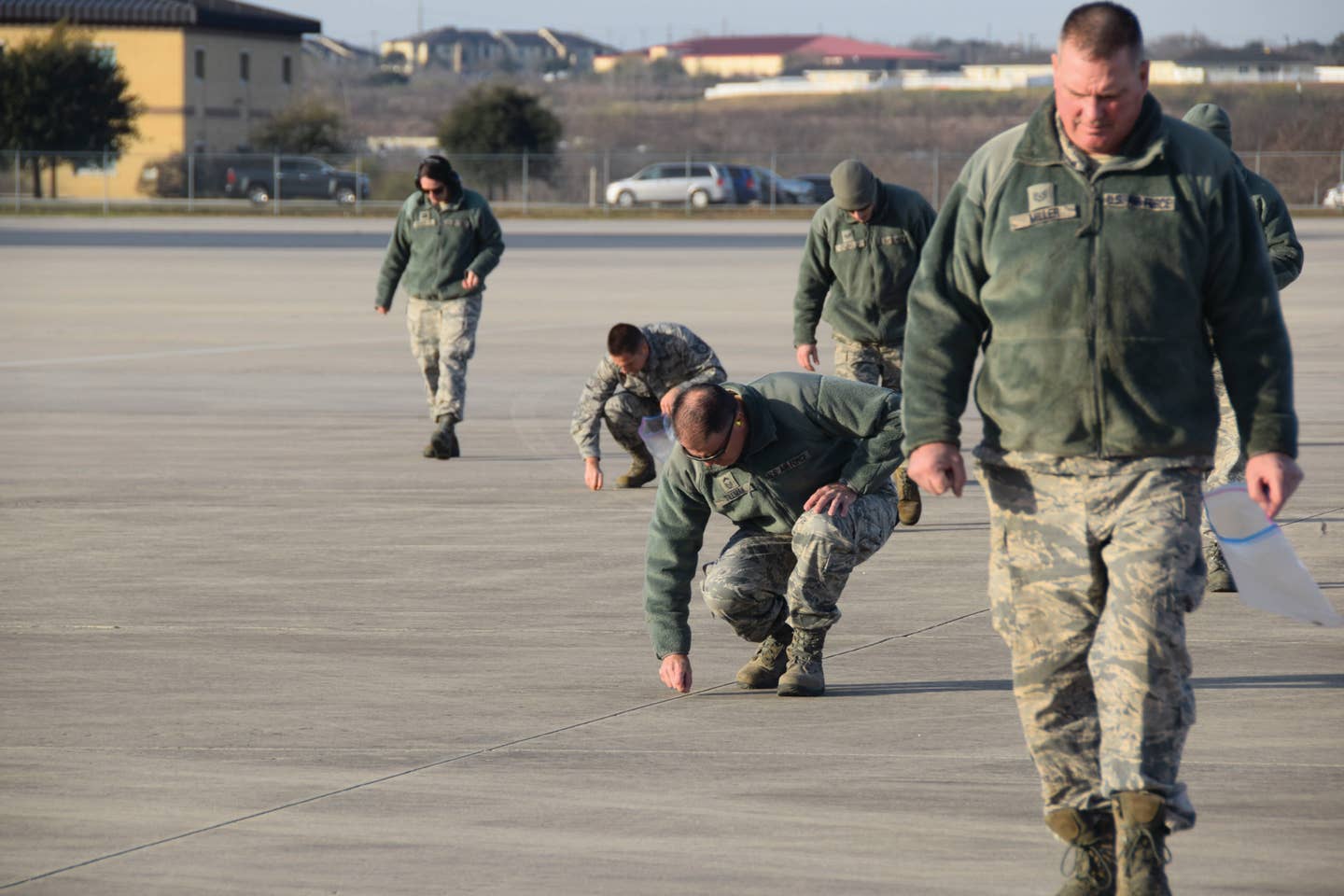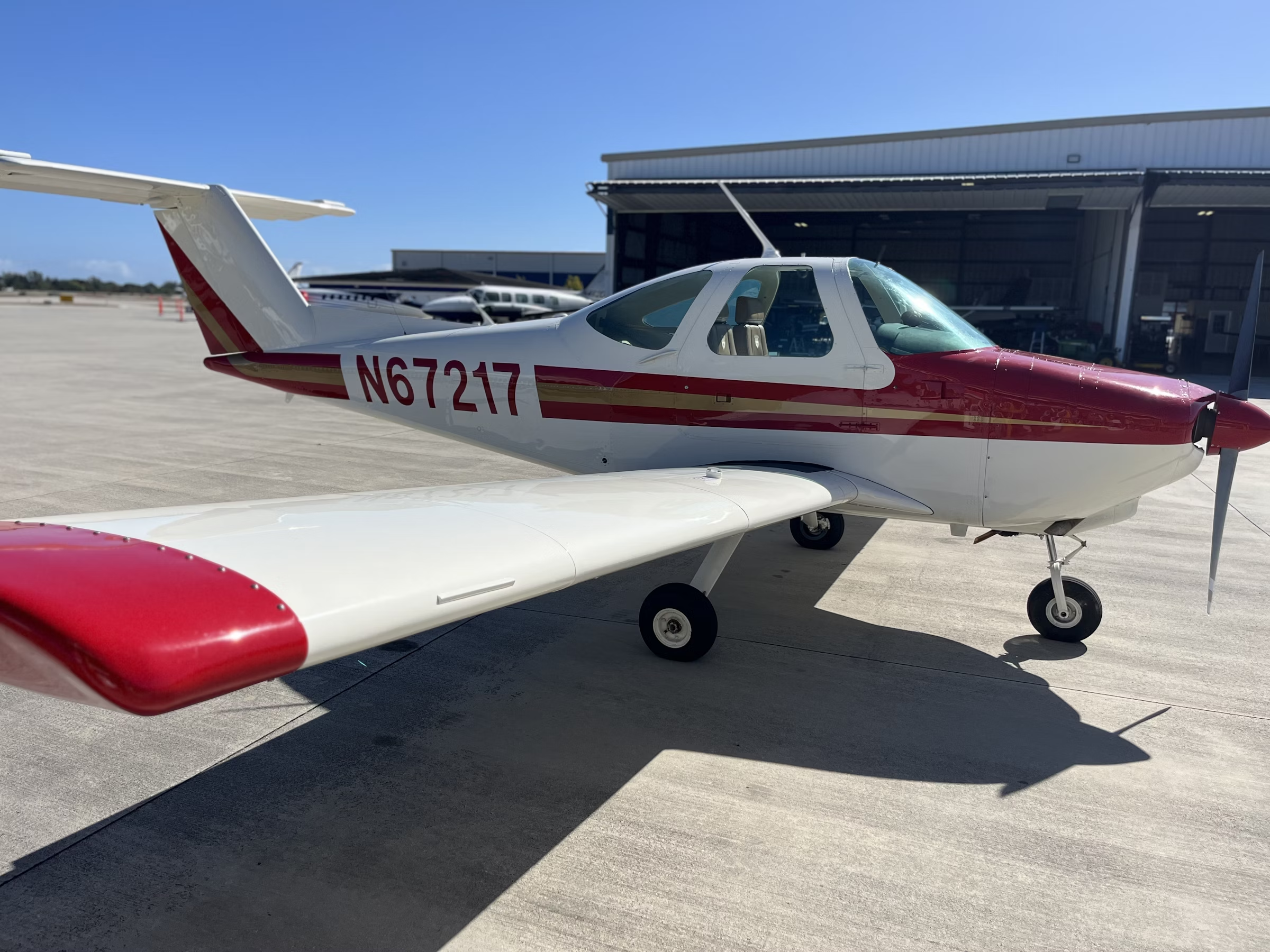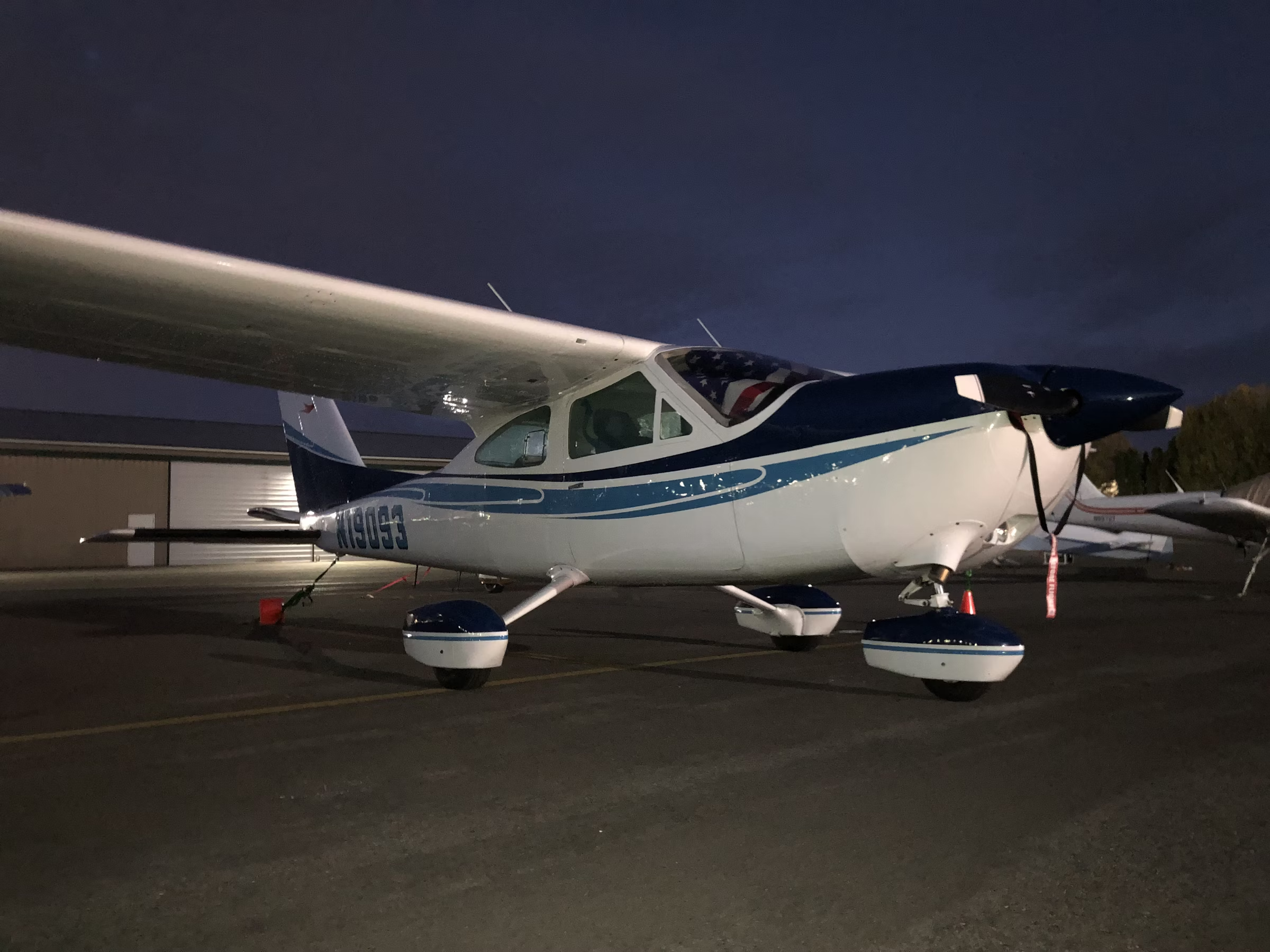Fight Against FOD Never Ends
Foreign object damage can often become the hidden killer for pilots.

433rd Airlift Wing members at Joint Base San Antonio-Lackland perform an FOD walk to clean foreign objects and debris from the flightline. [U.S. Air Force/Staff Sergeant Lauren Snyder]
“I believe I just ingested a flashlight.”
That statement is precisely what one does not wish to hear when test-running an aircraft following a maintenance event. The situation worsens when the aircraft is a $109 million F-35A Lightning II fighter. In January, Stars and Stripes reported that on March 15, 2023, “a hand-held flashlight left inside an F-35 engine by maintainers at Luke Air Force Base last year caused $4 million in damage.” It seems that after using a flashlight to inspect the poorly lit intake of the F-35, the maintainer failed to clear the tool before test-running the engine.
If you're not already a subscriber, what are you waiting for? Subscribe today to get the issue as soon as it is released in either Print or Digital formats.
Subscribe NowDuring the post accident investigation, investigators found a flashlight missing from one toolbox. The 56th Fighter Wing aircraft suffered an excess of $4 million in damage to the engine. Thankfully, no one was injured in the accident, but the engine could not be repaired locally.
This is a classic and all-too-common case of foreign object damage (FOD).
This Is FOD
FOD can be categorized as foreign object damage or debris based on the context one is referencing. FOD is a broad term that applies to just about anything. The FAA defines in Advisory Circular (AC) 150/5210-24 Airport Foreign Object Debris (FOD) Management that FOD is “any object, live or not, located in an inappropriate location in the airport environment that can injure the airport or air carrier personnel and damage aircraft.”
FAA AC No. 150/5380-5B Debris Hazards at Civil Airports addresses FOD and the ramifications of such. One key highlight states that “foreign objects on airport pavements can be readily ingested by aircraft engines, resulting in engine failure.” The FAA lists several possible FOD objects, many of which you will instantly identify as commonplace in aircraft operations. In section B of the AC, the FAA calls out “aircraft and engine fasteners (nuts, bolts, washers, safety wire, etc.); mechanics’ tools; flight line metal (nails, personnel badges, pens, pencils, etc.); stones and sand; paving materials; pieces of wood; plastic and polyethylene materials; paper products; and ice formations in operational areas.”
FOD-Related Accidents
Just how bad is the FOD problem? One might say that the issue is an epidemic. The FAA devotes quite a bit of attention to it, and rightly so. FOD is hazardous and can negatively impact operations.
The FAA website cites the Current Airport Inspection Practices Regarding FOD (foreign object debris/damage) report, stating that FOD exists in many forms, comes from many sources, and can be found anywhere in an airport's air operations area (AOA). The report explains how damaging FOD can be to aircraft, puncturing tires, punching holes in airframes, and nicking turbine blades or propellers. And in extreme cases, engine failure. Damage is not isolated to just aircraft or equipment. Airport employees are also susceptible to FOD-related injuries. Errant bolts or other foreign objects on the ramp could be propelled by prop wash, jet engine blasts, or helicopter rotors, turning them into mini-missiles.
- READ MORE: Breaking Down Sudden Stoppage Inspections
The report states that FOD costs the U.S. aviation industry $474 million annually. The global aviation industry’s losses are an estimated $1.26 billion annually. These totals include direct and indirect costs, such as flight delays. The FAA is asking for airports, airlines, and the general aviation community’s assistance in documenting the occurrence of FOD and submitting data to the FAA FOD database.
Despite all the awareness campaigns and actions taking place, FOD is still a significant problem that may be growing. A recent Air Force Times article states that “foreign object debris was one factor that led the number of ground accidents to nearly double from 11 in 2022 to 21 in 2023.” If anything, rates of occurrence are headed in the opposite direction. In March, USA Today reported that United Flight 1118, a Boeing 737 taking off from Houston’s George Bush Intercontinental Airport (KIAH) ingested bubble wrap into the engine, causing a midair fire. Thankfully, the incident did not result in injury.
Unfortunately, the losses are not solely in physical damage. One of the more infamous FOD-induced incidents did not fare so well. On July 25, 2000, Air France Flight 4590 departed Paris Charles de Gaulle Airport (LFPG). Prior to rotation, Concorde struck a piece of metal with its right front tire, causing it to explode and rupture the integral fuel tank. Fuel leaking from the ruptured tank ignited, creating a loss of thrust in engines 1 and 2. The aircraft lifted off momentarily but crashed into a hotel, killing all nine crew, 100 passengers, and four people on the ground.
The Bureau Enquêtes-Accidents (BEA) report identified the FOD as a Continental Airlines DC-10 thrust reverser door wear strip that had fallen off after maintenance.
FOD awareness and prevention deserves our attention. These examples and others illustrate that there is seemingly no end to stories of FOD causing significant property damage and loss of life, including one instance of a self-inflicted fatal FOD accident. Columbia STS-107 was lost and its space shuttle crew perished upon reentering the atmosphere while returning from a mission. According to NASA, a loose insulation panel dislodged and damaged the carbon heat shield material on the orbiter’s left wing, eventually causing the craft to succumb to the extreme heat of reentry.
FOD can come from a variety of sources, and not all incidents are the result of negligence—nature can be equally culpable. Most people are familiar with the story of Captain Chesley “Sully” Sullenberger and the “Miracle on the Hudson.” On January 15, 2009, US Airways Flight 1549 departed New York’s LaGuardia Airport (KLGA) bound for North Carolina’s Charlotte Douglas International Airport (KCLT). Approximately six minutes into the flight, the Airbus 320-214 ingested a flock of Canada geese, disabling both engines. Thankfully, Sullenburger’s skill saved the lives of all souls on board by safely ditching in the Hudson River.
Even smaller flying objects can cause huge problems. Andrew Warwick and Blake Love recently reported to KJWN in Nashville, Tennessee, for a service call. A Challenger 350 experienced a dual-engine, nonstart condition. They arrived to find the APU inlet packed with dead cicadas. It appears that cicadas are drawn to the APU’s warmth and noise. Operators in heavy cicada areas like this are advised to run their APUs sparingly and check for FOD frequently.
FOD Prevention
To begin a FOD prevention program, start with the following:
• Identifying causes.
• Establishing an FOD awareness program.
• Establishing a maintenance program.
The AC mentioned earlier then breaks down each of the above actions with detailed guidelines to help one succeed in the fight against FOD.
Another resource the FAA makes available is its Foreign Object Debris Program. The website (faa.gov/airports/airport_safety/fod) reveals several tools, resources, and technical publications for managing a successful FOD program.
Marcela White, co-owner of Tavaero Jet Charter, knows FOD is serious business. When asked who was responsible for FOD risk mitigation at Tavaero, White’s simple response was—everyone.
“Pilots, mechanics, and airplane cleaners are all trained to check for any FOD damage on the airframe or in the engines,” White said. “Pilots are the last line of defense and perform their preflights with a sharp eye. Anything beyond obvious visual damage gets escalated to the maintenance department. The job is not over after the flight either. The pilots go back through everything during post-flight inspections. Crewmembers follow an extensive checklist that includes servicing the aircraft fluids, cleaning the windows and windshields to ensure no chips are found, checking oxygen levels, and checking the airframe and engine blades for FOD.”
I met John Franklin, the head of safety promotion at the European Union Aviation Safety Agency (EASA), during the T-C-Alliance online coffee chats early in 2020. I asked Franklin about his legacy of fighting FOD.
“In terms of FOD, it’s where I started my safety career, as the U.K. Defense FOD Prevention Officer, or the ‘Fodfather’ as it was called at the time,” he said with a smile.
Franklin broke down the steps EASA is taking to raise FOD awareness.
“From our side, we are trying to promote the topic wherever the opportunity arises,” he said.
“Every year, the EASA team participates in the annual FOD Walk at our local airport at Dusseldorf [Germany]. This provides a great opportunity to promote the importance of active FOD prevention. After the FOD Walk last year, we published an article on our Air Ops Community website [easa.europa.eu/community/topics/fod-prevention].”
Even with all EASA’s efforts, more work remains, especially with regard to getting the word out.
“We also promote FOD, particularly when we have other promotional events and webinars on maintenance safety and airport ground handling,” Franklin said. “From our analysis, these certainly seem to be the communities that have the largest role in stopping FOD from causing a safety issue to an aircraft. Additionally, we promote the topic of clean cockpits to airlines having had some occurrences with FOD jamming flight controls or causing other problems to avionics.”
Much like a 12-step program, Franklin recognizes that awareness of the FOD problem is only the first step. One must put in parameters to stop FOD at the source.
“It’s also important to have a FOD analysis program to further identify the sources of FOD, so you can manage them at the source,” he said. “There is no point just continually cleaning away FOD without thinking where it is coming from and how to stop it.”
How the Experts Stop FOD
FOD control begins with attention to detail, tool control, and housekeeping. There are solutions designed with this in mind. FODS LLC, located in Centennial, Colorado, provides FODS mats to prevent any material from entering the airfield by clearing the tire treads before entering the airport. They recently completed a project at Terminal 5 at Chicago O’Hare International Airport (KORD).
I asked some of the top names in the industry to help me map out strategies to deal with FOD. James Logue, the director of maintenance at Latitude 33 Aviation in Carlsbad, California, told me how his team approached the FOD issue, and provided a new perspective.
“It’s important to think about FOD proactively,” Logue said. “Think about an object and its placement in terms of how it might become FOD. I’ve seen large water bottles in a galley cabinet leak out, causing water to get under the floor and into the belly, then freezing in flight, causing a fuel valve cable to become jammed. Consider what can happen if an item breaks, spills, moves in flight, where it might migrate to, what holes it could fall in, etc.”
Despite best efforts, FOD will eventually find its way to the airport. But once you identify an object as FOD, how do you dispose of it?
Foreign Object Debris is a company specializing in FOD receptacles. According to its website (foreignobjectdebris.com), the firm “educates the community about FOD in hopes of helping to save a loss of money and potentially lives.” If you visit the site, check out its series of FOD blogs.
Jon Byrd, executive director of aviation and TCSG state aviation program adviser for Georgia Northwestern Technical College (GNTC) in Rome, contracts with Shark-Co Manufacturing to build custom foam molds that incorporate the minimum tool list and fit them into the student’s toolbox. This could have helped out the F-35 maintainer with the missing flashlight.
Speaking of tooling, Snap-on now sells a line of FOD prevention tools. I recently read about its quarter-inch Drive Dual 80 Technology Standard Handle Foreign Object Damage Ratchet design online and how it helps to prevent FOD in sensitive work environments. The cover plate and reverse lever are permanently affixed to the ratchet head with rivets to prevent debris from small parts. The tool meets FOD and foreign material exclusion (FME) program conformance.
Duncan Aviation is the world's largest privately owned business jet service provider. I recently met with the team and inquired about Duncan’s FOD efforts. Darwin Godemann, the team leader of the Technical Education Center, offered the following insights: FOD can be anything—a wrench, pen, eyeglasses, or even rocks and stones, and i originate in many ways—objects falling out of pockets, a wayward tool, dirt and debris, or a pilot spilling their coffee.
FOD does pose a significant threat to aircraft, one that can cost the operator tens of thousands of dollars and compromise the safety of the aircraft and its function. For example, debris can result in improper stress and wear on a wire, causing an electrical fire. Coffee spilled six months ago can drip into nooks and crannies and cause corrosion. A tool left where it shouldn’t be can shift and jam a flight control. Debris from an airfield can be sucked into an engine.
Here are some examples of Duncan Aviation’s program:
• Tool control policies require shadowboxing all toolboxes and the end-of-work inventorying of tools
• Regular FOD awareness and training with a clean-as you-go policy. If you see something, pick it up.
• Double-inspection systems. Before it puts a panel back on or closes an area of the aircraft opened for work, a second set of eyes checks it out. In addition to a QA check, this ensures there is nothing in there that doesn’t belong.
• Awareness campaigns companywide. The line department tugs have magnets under them that pick up magnetic objects as they drive on the ramp.
Here are Duncan’s best practices implemented to develop an MRO FOD program:
• General housekeeping: A clean-as-you-go mentality is the most important first step in FOD prevention.
• Effective tool control system: Account for all tooling regularly and at the end of a job. Inventory lists or tool shadowing make this task much easier.
• OK to close inspection: Inspecting all areas where maintenance was performed to ensure nothing unwanted is left behind.
FOD control is potentially everyone’s problem, so it’s also everyone’s responsibility. Safety is mission critical in aviation. Failure to control FOD could be deadly.
This feature first appeared in the July/August Issue 949 of the FLYING print edition.

Sign-up for newsletters & special offers!
Get the latest FLYING stories & special offers delivered directly to your inbox







